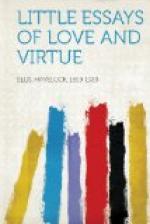There is something pathetic in the spectacle of those among us who are still only able to recognise the animal end of marriage, and who point to the example of the lower animals—among whom the biological conditions are entirely different—as worthy of our imitation. It has taken God—or Nature, if we will—unknown millions of years of painful struggle to evolve Man, and to raise the human species above that helpless bondage to reproduction which marks the lower animals. But on these people it has all been wasted. They are at the animal stage still. They have yet to learn the A.B.C. of love. A representative of these people in the person of an Anglican bishop, the Bishop of Southwark, appeared as a witness before the National Birth-Rate Commission which, a few years ago, met in London to investigate the decline of the birth-rate. He declared that procreation is the sole legitimate object of marriage and that intercourse for any other end was a degrading act of mere “self-gratification.” This declaration had the interesting result of evoking the comments of many members of the Commission, formed of representative men and women with various stand-points—Protestant, Catholic, and other—and it is notable that while not one identified himself with the Bishop’s opinion, several decisively opposed that opinion, as contrary to the best beliefs of both ancient and modern times, as representing a low and not a high moral standpoint, and as involving the notion that the whole sexual activity of an individual should be reduced to perhaps two or three effective acts of intercourse in a lifetime. Such a notion obviously cannot be carried into general practice, putting aside the question as to whether it would be desirable, and it may be added that it would have the further result of shutting out from the life of love altogether all those persons who, for whatever reason, feel that it is their duty to refrain from having children at all. It is the attitude of a handful of Pharisees seeking to thrust the bulk of mankind into Hell. All this confusion and evil comes of the blindness which cannot know that, beyond the primary animal end of propagation in marriage, there is a secondary but more exalted spiritual end.
It is needless to insist how intimately that secondary end of marriage is bound up with the practice of birth-control. Without birth-control, indeed, it could frequently have no existence at all, and even at the best seldom be free from disconcerting possibilities fatal to its very essence. Against these disconcerting possibilities is often placed, on the other side, the un-aesthetic nature of the contraceptives associated with birth-control. Yet, it must be remembered, they are of a part with the whole of our civilised human life. We at no point enter the spiritual save through the material. Forel has in this connection compared the use of contraceptives to the use of eye-glasses. Eye-glasses are equally un-aesthetic, yet they are devices, based on Nature, wherewith to supplement the deficiencies of Nature. However in themselves un-aesthetic, for those who need them they make the aesthetic possible. Eye-glasses and contraceptives alike are a portal to the spiritual world for many who, without them, would find that world largely a closed book.




